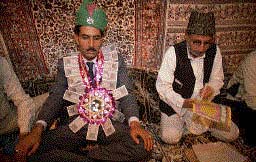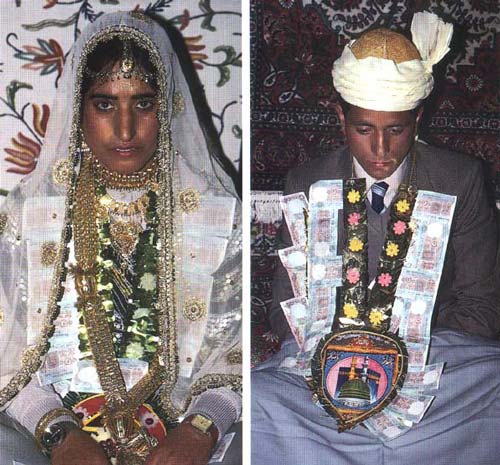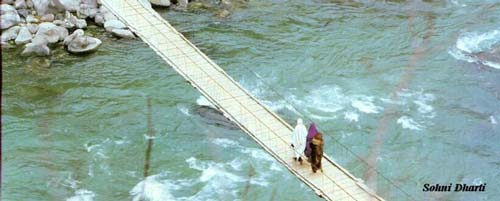
HOME
WEDDING
CUSTOMS
KASHMIRI MUSLIM WEDDINGS
KASHMIRI MUSLIM WEDDINGS

A Kashmiri groom
Text reprinted from the Edulhadulhan.com
website
Introduction
When we hear or talk about Kashmir we cannot forget to talk about the Himalayas, the misty valleys, the houseboats and shikaras or the beautifully embroidered shawls, and course the fair sharp-featured and the good-looking people of Kashmir.
The Kashmiris are not only blessed with the beautiful landscape but also with beautiful looks.
 A Kashmiri bride and groom |
The economy of Kashmir runs basically on tourism and secondly on handicrafts. The 'shakish' shawls, which are now banned, can be quite exquisite and expensive.
The richness of the land is also shown in the wedding ceremonies of Kashmir. In the past the wedding functions streched for days together but today when the circumstances are different the wedding ceremonies have been cut down. Let us see how a Kashmir wedding takes place.
Thap
'Thap' literally means to catch somebody and in this ceremony the boy and the girl engage each other for a marriage. The meeting of the boy and the girl is often outside the home, in public places (although it is common to meet inside the home also). The main reason for meeting outside is that if the boy does not approve of the girl the two can separate easily rather than meeting up at home and getting deeper in the situation. The couple usually meets at 'durgahs' mosques or even the Mogul gardens.
Amongst Kashmiri Muslims the girl often does not have the freedom to reject the boy whereas it is possible for the boy to reject a girl. So when a girl comes for the 'thap' she has already accepted him as her man and she has to wait for the boy's side of the family to express their acceptance of the match.
When the couple accepts each other, jewelry is often given to the bride by the groom's family, and sometimes rings and flowers are exchanged. After the exchange of rings and flowers the two families return to their respective homes where their close relatives are ready to welcome them.
In the next few days to come the girl's side of the family have to send 'vazvan' to the boy's house. 'Vazvan' is an exclusive meal prepared by special Kashmiri cooks. It consists of 50- 60 dishes prepared with exclusive herbs and spices. Chefs called 'vazas' cook the 'vazvan' food and this food is cooked specially during wedding ceremonies.
Big vessels are filled with vazvan dishes, which mainly consists of 10-15 items of mutton another 10-15 items of chicken and also many varieties of biryanis.
When a wedding is fixed in a Kashmiri family up to 40 vazas are employed for cooking the feast. Big Kashmiri houses have special provisions to put up 'vazas' for the next few days and also have enough capacity to store the big 'deyhs' (vessels) used to cook vazvans.
The 'vazvan' food is sent to the boy's house where this food is distributed by the boy's family to their close relatives and friends. The arrival of vazvan dishes at the relatives place signifies the announcement of the engagement of the boy.
Engagement Ceremony
There are two types of engagements and the couple's parents can decide which engagement ceremony they would prefer. The first type of engagement ceremony is called 'Nikaah' where for all religious and practical purposes the couple is married to each other. Some Kashmiri's have a 'nikaah' ceremony but the girl continues to stay with her parents in other cases after the 'nikaah' engagement the girl moves in with her fiance in his house.
The second type of engagement ceremony is called 'Mabadh' ceremony. This type of an engagement ceremony has to be late followed by a proper 'nikaah' or a wedding ceremony. Let us new discuss in detail both the engagement ceremonies
Nikaah Ceremony
In complete sense this is a wedding ceremony after which the bride and the groom are considered married.
The girl applies mehendi on her palms and legs a couple of days before the engagement ceremony. In the past when the 'Shatush shawls' were not banned the girl's family use to present the boy's family members with 'shatush' shawls (made from the hide of the shatush deer). The boy does not accompany his relatives to the girl's house but instead he sends his 'Vakil' (representative), which can be his mamu (maternal uncle) or chacha (paternal uncle). The girl is presented with jewellery and clothes. The 'nikaah' is read by the 'maulvi' (priest). The girl's family sends gifts to the boy's house, which is called 'haziri'. Gifts are sent along with 'majmas' (big copper thalis) full with sweets, dry fruits, jams, fresh fruits etc. The number of 'Majmas' sent can be seven or eleven or even hundred.
The boy's side of the family is invited to dinner where the 'vazvan' food is served which may consist of 30-35 dishes. The menu includes 4 to 5 different types of chutneys, 4-5 chicken dishes, and many more mutton dishes. A special item 'mudjan' (sweet pulav) is also served.
After the relatives leave, the family friends are invited. The friends are served a special Kashmiri tea known as 'kehwa'. Kehwa is a herbal tea brewed in by copper pots. Kehwa is served with 'Shirmal' a special type of Kashmiri roti.
On the day of the engagement the girl is made to change her 'lehenga' three to four times.
Nikaah Dinner
In the past the Kashmiri weddings use to take place at midnight, but these days due to uncertain circumstances weddings are held early in the evening. Dinner is served early, for the convenience of the guests. The food served is the same 'vazvan' food served with Kashmiri phirni, halwa and kulfi. The ladies and men are seated separately. The close relatives of the boy can enter the shamiana where the girl is seated. The relatives take a look at the bride and also give her gifts.
The engagement period can be for a couple of months extended to a couple of years. When the boy's parents decide to brings the bride home a wedding function is organised. There are no rituals and rites to be performed on the wedding day but it is only a get together of the two families. The wedding functions are organised for three days.
1st Day Function
This function is organised at the girl's place and is called 'Muchravum'. On this day the girl ties small plaits to her hair, which are later unbraided by all the married ladies of the family. The ladies unbraid the plaits and apply oil to the bride's hair. The function is accompanied by good amount of fun and teasing and winds up with everyone showering their choicest blessings on the bride.
2nd Day Function (Mehendi)
Small, unmarried girls from the boy's family get mehendi for the bride. The girls apply mehendi on the bride's hands and feet. The bride is bedecked in all her bridal jewellery. The mehendi function is followed by a dinner. The men of the family are given respect and served special food on this day. The groom's sister applies mehendi on his little finger.
3rd Day Function
On this day the baraat comes to the bride's house. The baraat is called 'Yenevol'. The bride is dressed in a red lehenga. On this day the bride is given a bath (ghusul) by her mother and aunts and then she is dressed in the traditional salwar kameez.
There is a small get together in the girl's house before the arrival of the baraat. The bride's mamis (maternal aunts) stay back for the function and when the baraatis come they are served 'kehwa'. The ladies from the groom's side do not attend the function.
The ladies in the family sing traditional wedding songs called 'vanvun'. The groom is showered with coins and almonds. All the relatives present at this function garland the groom.
The groom is then served dinner in big plates called 'tramis'. The baraatis are served food along with phirni, halwa, rasmalai and kulfi.
The amount of the meher is fixed at this time. This usually does not exceed rupees one lakh. Meher is a sum of money, which the husband has to give his wife anytime after marriage and in case there is a divorce the amount has to be given immediately.
The groom wears a special turban called 'karakuli topi' when he enters the house. In the meanwhile the bride finishes her packing and the couple gets ready to leave.
The groom enters the car before the bride and asks for permission to take away the bride.
 Crossing a bridge in Kashmir |
The next seven days see a plethora of guests, bearing gifts and dry fruits, visiting the respective homes of the boy and the girl. On the third or the fourth day after the wedding the bride and the groom visit the girl's home.
They are served an elaborate dinner. On the seventh day the bride's aunts visits her and a small party is organised. Following this they take the bride with them for a few days.
With all these functions the wedding comes to an end.
 BACK
TO WEDDING CUSTOMS
BACK
TO WEDDING CUSTOMS
